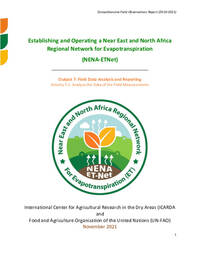Field Data Analysis and Reporting Activity 7.1: Analyze the Data of the Field Measurements

Authors:
Reliable spatiotemporal measurements of evapotranspiration (ETa) are important for water resources planning, management and monitoring, efficient irrigation scheduling, and development and monitoring of climate change mitigation scenarios. Due to complex land-plant-atmosphere interactions and natural variability in topography, soil moisture and vegetation type, obtaining accurate information on ET is often challenging, especially in agroecosystems where water is scarce or fluctuates seasonally. There are several conventional field methods used to determine ETa, including: 1) the Eddy covariance/energy balance method; 2) the Bowen-ratio/energy balance method; 3) Weighing lysimeters; 4) Soil-moisture depletion method; and 5) Large Aperture Scintillometer. These methods have their own specific advantages and limitations based on the theory behind and on the instrumentation requirements. However, what they have in common is, among others, the restricted sampling area and the complexity and extremely high costs when attempting to scale-up to larger areas. For large scales (e.g., watershed, sub-national, national and regional), ETa estimation is often established through satellite Remote Sensing (RS), due to progress that has been made in space science in recent years. There are several well-established RS-based algorithms for the determination of ETa, including SEBAL (Surface Energy Balance Algorithm for Land), METRIC (Mapping Evapotranspiration at high Resolution with Internalized Calibration), SEBS (Surface Energy Balance System), ETLook, ETMonitor, etc. Unfortunately, these methods also have their own specific advantages and limitations and are all suffering from a generally limited and scattered field testing. Virtually no testing is systematically carried out in the NENA Region. Therefore, the Water Scarcity Initiative (WSI) of FAO for the Near East and North Africa conceived and promoted the establishment of this ET-Network so that ETa field data could effectively be used to test and calibrate the remote sensing-based estimations.
